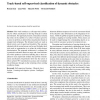Free Online Productivity Tools
i2Speak
i2Symbol
i2OCR
iTex2Img
iWeb2Print
iWeb2Shot
i2Type
iPdf2Split
iPdf2Merge
i2Bopomofo
i2Arabic
i2Style
i2Image
i2PDF
iLatex2Rtf
Sci2ools
AROBOTS
2010
2010
Track-based self-supervised classification of dynamic obstacles
Abstract This work introduces a self-supervised architecture for robust classification of moving obstacles in urban environments. Our approach presents a hierarchical scheme that relies on the stability of a subset of features given by a sensor to perform an initial robust classification based on unsupervised techniques. The obtained results are used as labels to train a set of supervised classifiers. The outcomes obtained with the second sensor can be used for higher level tasks such as segmentation or to refine the within-clusters discrimination. The proposed architecture is evaluated for a particular realization based on range and visual information which produces track-based labeling that is then employed to train supervised modules that perform instantaneous classification. Experiments show that the system is able to achieve 95% classification accuracy and to maintain the performance through on-line retraining when working conditions change. Keywords Self-supervised learning
AROBOTS 2010 | Initial Robust Classification | Robust Classification | Self-supervised Architecture |
| Added | 08 Dec 2010 |
| Updated | 08 Dec 2010 |
| Type | Journal |
| Year | 2010 |
| Where | AROBOTS |
| Authors | Roman Katz, Juan Nieto, Eduardo Mario Nebot, Bertrand Douillard |
Comments (0)

